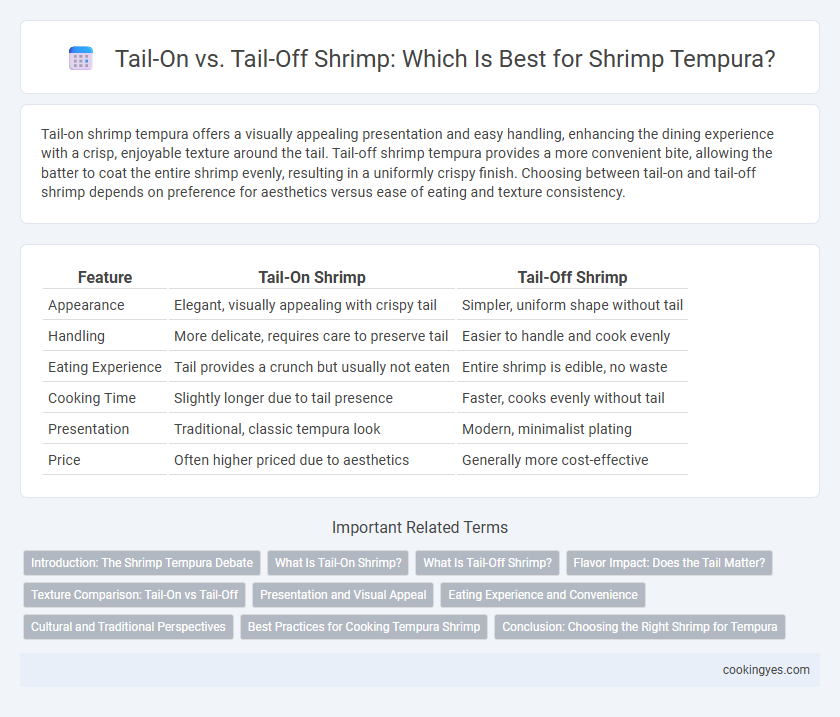Tail-on shrimp tempura offers a visually appealing presentation and easy handling, enhancing the dining experience with a crisp, enjoyable texture around the tail. Tail-off shrimp tempura provides a more convenient bite, allowing the batter to coat the entire shrimp evenly, resulting in a uniformly crispy finish. Choosing between tail-on and tail-off shrimp depends on preference for aesthetics versus ease of eating and texture consistency.
Table of Comparison
| Feature | Tail-On Shrimp | Tail-Off Shrimp |
|---|---|---|
| Appearance | Elegant, visually appealing with crispy tail | Simpler, uniform shape without tail |
| Handling | More delicate, requires care to preserve tail | Easier to handle and cook evenly |
| Eating Experience | Tail provides a crunch but usually not eaten | Entire shrimp is edible, no waste |
| Cooking Time | Slightly longer due to tail presence | Faster, cooks evenly without tail |
| Presentation | Traditional, classic tempura look | Modern, minimalist plating |
| Price | Often higher priced due to aesthetics | Generally more cost-effective |
Introduction: The Shrimp Tempura Debate
Tail-on shrimp tempura retains the shell's end, enhancing presentation and providing extra texture for an authentic crispy bite. Tail-off shrimp tempura offers ease of eating and cleaner plating, preferred in fine dining or sushi-style tempura dishes. Debate centers on balancing traditional aesthetics versus practical consumption in shrimp tempura preparation.
What Is Tail-On Shrimp?
Tail-on shrimp for tempura refers to shrimp with the shell removed but the tail segment left intact, enhancing presentation and providing a convenient handle while eating. This style retains the shrimp's natural shape and adds a crispy texture to the tail, contrasting with the tender battered body. Using tail-on shrimp is popular in Japanese tempura to balance aesthetics, flavor, and eating experience.
What Is Tail-Off Shrimp?
Tail-off shrimp in tempura refers to shrimp that have been fully peeled and deveined, with the tail removed for easier eating and presentation. This preparation style enhances the batter's adhesion and creates a uniform texture, allowing for consistent frying and a delicate, crispy finish. Tail-off shrimp are preferred in dishes where ease of consumption is prioritized, offering a bite-sized tempura experience without the need to remove the tail while eating.
Flavor Impact: Does the Tail Matter?
Tail-on shrimp for tempura enhances flavor by retaining natural juices and providing a slightly sweeter, brinier taste due to the shell's protection during frying. Tail-off shrimp offers a cleaner bite, allowing the batter's crispiness and seasoning to stand out without the subtle taste influence from the shell. The choice impacts the overall flavor profile, with tail-on shrimp delivering a richer, more intense shrimp essence in tempura dishes.
Texture Comparison: Tail-On vs Tail-Off
Tail-on shrimp in tempura offer a firmer, more satisfying bite due to the natural structural support of the tail, enhancing the overall texture experience. Tail-off shrimp provide a smoother, more uniform texture that melds seamlessly with the crispy tempura batter, allowing the delicate shrimp flavor to stand out. Choosing between tail-on and tail-off shrimp tempura depends on preference for a crisp bite versus a tender, integrated texture.
Presentation and Visual Appeal
Tail-on shrimp in tempura enhance presentation by providing a natural, elegant silhouette that adds height and texture to the dish. The bright, curved tails contrast visually with the golden, crispy batter, making the tempura more attractive and appetizing. In contrast, tail-off shrimp offer a cleaner look for easier eating but sacrifice the dynamic visual appeal that the intact tails provide on a plating.
Eating Experience and Convenience
Tail-on shrimp for tempura offers a more visually appealing presentation and provides a convenient handle for dipping, enhancing the eating experience. Tail-off shrimp, on the other hand, delivers easier consumption without needing to navigate the tail, making it ideal for bite-sized servings and quick meals. Both options balance texture and taste, but tail-on shrimp emphasizes aesthetics and handling, while tail-off prioritizes convenience and ease of eating.
Cultural and Traditional Perspectives
Tail-on shrimp is traditionally favored in Japanese shrimp tempura for its authentic presentation and cultural symbolism of completeness and respect. In contrast, tail-off shrimp is often used in non-traditional settings for ease of eating and convenience, reflecting a more modern, Western-influenced approach. This distinction highlights the balance between preserving culinary heritage and adapting to contemporary dining preferences.
Best Practices for Cooking Tempura Shrimp
Tail-on shrimp offers a better grip for dipping and frying, ensuring even cooking and preserving the shrimp's natural juices during tempura preparation. Tail-off shrimp allows for quicker cooking and easier eating, providing a more uniform batter coverage and avoiding burnt tails. Selecting the appropriate style depends on presentation preference and cooking technique, with tail-on favored for texture and appearance, while tail-off suits faster, mess-free consumption.
Conclusion: Choosing the Right Shrimp for Tempura
Tail-on shrimp offers a visually appealing presentation with added texture, enhancing the traditional tempura experience, while tail-off shrimp provides convenience and ease of eating, especially in dishes where a cleaner bite is preferred. Selecting the right shrimp depends on whether presentation or practicality is prioritized, with tail-on favored in formal settings and tail-off suited for casual or quick-service meals. Ultimately, both options deliver delicious tempura when fresh shrimp and proper frying techniques are used.
Tail-on shrimp vs tail-off shrimp for shrimp tempura Infographic

 cookingyes.com
cookingyes.com